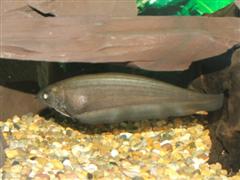Knife - African Brown
African Knife, African Knifefish, Black Knifefish Scientific Name: Xenomystus nigri
Mon, 23rd June, 2025 - 5:29 am GMT
Sponsor Ads:

Alternative Name
African Knife, African Knifefish, Black Knifefish Scientific Name: Xenomystus nigriBasic Info
The African Knifefish can grow to be quite large. When mature, they average 12 inches in length, which is much ae than sm f the other knife species. They are still large fish, and for this reason they should be kept in a relatively large tank 20 to 45 gallons. The Knifefish has one continuous fin in place of the caudal and anal fin, which looks like a knife. This fin is undulated, enabling it to swim forward and backward. When not open, the Knifefish's mouth looks small. It can open quite wide, however, to eat small fish. The African Knifefish has the unusual ability to produce sounds during mating and danger situations. The sounds are produced by pushing air through their swimbladders.
Health
African Knifefish enjoy the normal frozen fish foods, and fish. These include beef heart, blood worms, muscles, earth worms, and occasionally flakes. They have a narrow temperature acceptance, from 72 to 80 degrees fahrenheit. African Knifefish need lightly acid water, with pH from six to six and a half. They do not like too much light, and need rocks and caverns to hide in. Tank chemicals can easily irritate the African Knifefish. This is because this breed has very small scales. If disease appears in the tank it is important to bear this in mind before treating the tank chemically. Breeding It is rare for an African Knifefish to breed in captivity. When it does, however, each spawn has 150 to 200 eggs in it, which are laid on a piece of wood or a rock. The male will guard the eggs, and fan them with his fins. The Knifefish makes sounds during courtship.Habitat
Fresh water fish -Their native habit generally consists of still waters.Behavior
The African Knifefish, also known as the African Knife, Brown African Knife, and Black Knifefish, is pretty and graceful. It has the ability to swim backwards and forwards, which make it especially aesthetic. African Knifefish have interesting personalities. When first introduced into a new aquarium, they will be rather timid, and will shy away from food and other fish. However, after adjustment, the Knifefish will happy. As the fish matures, it will not tolerate many other fish, and will be a loner. Adding the fact that the African Knifefish is a predator that hunts small fish, the African Knifefish is not a good fish for a densely populated tank. However, it will live peacefully with other large fish. Knifefish should never share a tank with another Knifefish, because they will fight. Suitable fish include, Synodontis Catfish, Elephant Noses, and Baby Whales. They are nocturnal animals, and prefer a dimly lit tank, with dense plant life. An ideal home for the Knifefish is a dark PVC tube. They like floating plants, and dark rocky substrates.Origin
AfricaHistory
African Knifefish, or Xenomystus nigri, are found in Africa and Southeast Asia.Common Foods
Small fishSponsor Ads:
Yea, though I walk through the valley of the shadow of death, I shall fear no evil, 'cause I'm the meanest S.O.B. in the valley. -- Unknown
Knife - African Brown
Coded by: BGID® | ALL RIGHTS RESERVED Copyright © 2000-2025
Disclaimer | Privacy | Report Errors / Contact | Credits
















